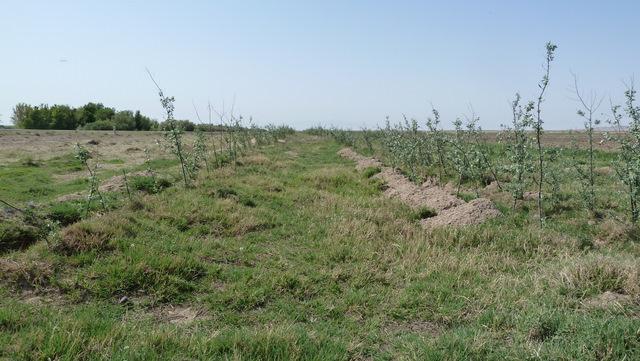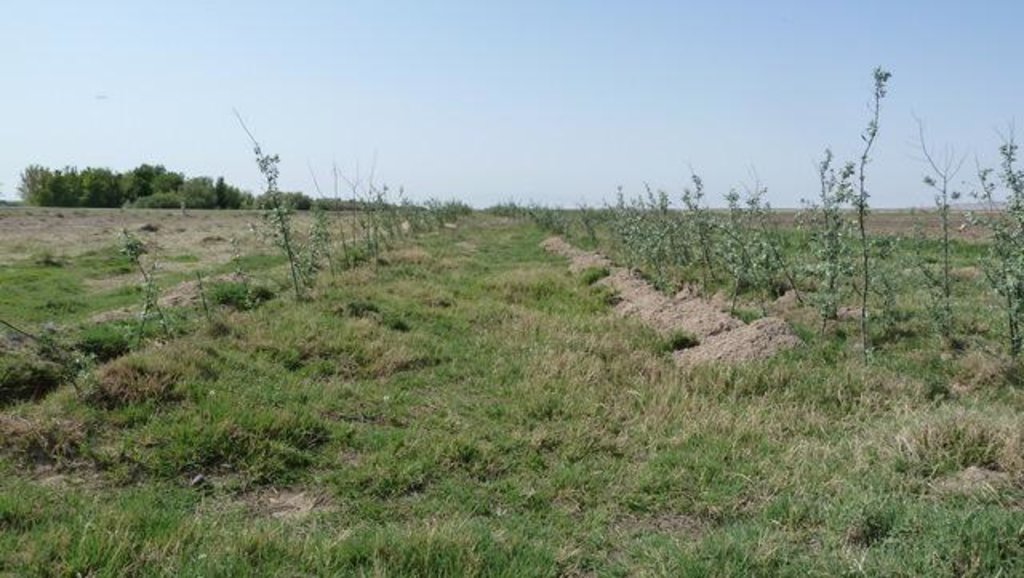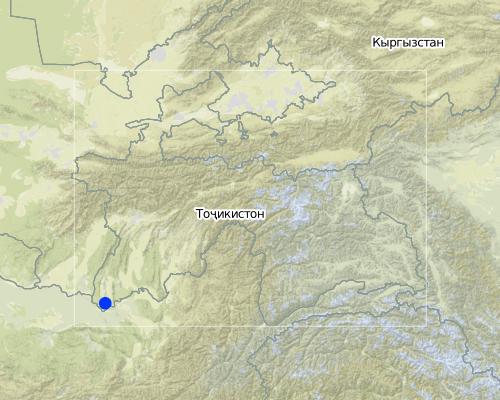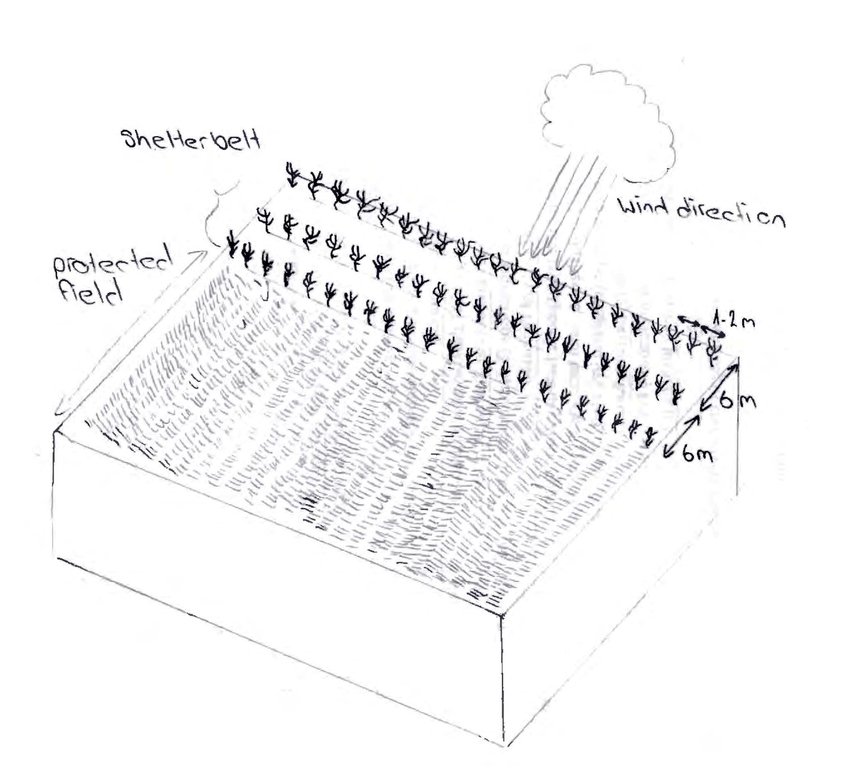Shelterbelts with Russian Silverberry for the protection of irrigated fields [Tajikistan]
- Creation:
- Update:
- Compiler: Firdavs Faizulloev
- Editor: –
- Reviewer: Deborah Niggli
Tajikistan - Central Asian Countries Initiative for Land Management (CACILM/ИСЦАУЗР)
technologies_1458 - Tajikistan
- Full summary as PDF
- Full summary as PDF for print
- Full summary in the browser
- Full summary (unformatted)
- Shelterbelts with Russian Silverberry for the protection of irrigated fields: Jan. 4, 2017 (inactive)
- Shelterbelts with Russian Silverberry for the protection of irrigated fields: Julie 20, 2017 (inactive)
- Shelterbelts with Russian Silverberry for the protection of irrigated fields: Aug. 21, 2019 (inactive)
- Shelterbelts with Russian Silverberry for the protection of irrigated fields: Nov. 2, 2021 (public)
View sections
Expand all Collapse all1. General information
1.2 Contact details of resource persons and institutions involved in the assessment and documentation of the Technology
SLM specialist:
SLM specialist:
Ibragimov Firuz
(+992 44) 600 55 19
firuz.ibragimov@undp.org
National Capacity Building Coordinator, Energy and Environment Programme, UNDP Tajikistan
Tajikistan
Name of project which facilitated the documentation/ evaluation of the Technology (if relevant)
Central Asian Countries Initiative for Land Management (CACILM I)Name of project which facilitated the documentation/ evaluation of the Technology (if relevant)
Pilot Program for Climate Resilience, Tajikistan (WB / PPCR)1.3 Conditions regarding the use of data documented through WOCAT
When were the data compiled (in the field)?
14/04/2011
The compiler and key resource person(s) accept the conditions regarding the use of data documented through WOCAT:
Ja
1.4 Declaration on sustainability of the described Technology
Is the Technology described here problematic with regard to land degradation, so that it cannot be declared a sustainable land management technology?
Nee
2. Description of the SLM Technology
2.1 Short description of the Technology
Definition of the Technology:
Shelterbelts are used to protect irrigated land from deposition of sand and to reduce wind speed
2.2 Detailed description of the Technology
Description:
This technology consists of shelterbelts made of Russian Silverberry (Elaeagnus angustifolia) to protect irrigated wheat and rice fields from strong winds.
In the Shaartuz area wind erosion poses huge problems to crop cultivation as topsoil is being removed and deposited as sediments on neighbouring fields. Dusty storms not only damage the crops but they also cause damage to the main surface, the fertile layer of soil. Sand also damages the irrigation canals, roads, gardens and streets in urban areas which forces people to leave such areas. Good yields cannot be achieved if fields are not properly protected.
A solution to this problem is the planting of shelterbelts around fields to slow wind speed and to prevent erosion of the arable soil layer. During Soviet times shelterbelts were planted on collective farms by the state forestry committee under contracts. After the collapse of the USSR and before the formation of Dehkan farms land users were not interested in investing in shelterbelts due to unprotected land use rights and unclear legal procedures. One farmer however tested the planting of a shelterbelt in 1992 when his son came back from his studies at the Agricultural University where he had learnt about the technology. They planted the first shelterbelt using a mixture of different tree species to protect newly irrigated fields. Due to financial constraints they could not invest in any other shelterbelts but in 2010 UNDP provided them with financial support to buy seedlings to increase the shelterbelt area. For this new shelterbelt the native Russian Silverberry (Elaeagnus angustifolia) was considered the most appropriate species as soils were highly saline and only this species proved tolerant.
Trees were planted in three rows, along field boundaries and also along irrigation channels. Within rows trees were spaced at a 1m interval with a 6 m distance between rows. The plantations were established through “haschar” (voluntary neighbourhood help) with 30 people planting about 10,000 trees within one month. During the first three years after planting the saplings need regular irrigation and sanitary cleaning to help establish themselves. After 6-7 years the trees start drawing a lot of water from the soil which prevents the irrigated soils from damage through water logging. Russian silverberry can grow up to 12 m in 10-12 years.
Benefits of these shelterbelts are increased crop yields (wheat and rice) due to the protection from strong winds and decreased evapotranspiration. Thanks to the species association with nitrogen fixing root bacteria soil fertility is improved. The trees further produce edible fruits and provide valuable firewood that is consumed by the households. Russian Silverberry is resistant to pests and diseases and drought-tolerant once established; however, it requires a lot of water during the first few years. One constraint to the establishment of the shelterbelt is local people who often cut down branches for firewood. The farmer therefore has to guard his field whenever possible with the help of his family and staff he has employed to work on his field. Implementation of forestry initiatives began in 2009 and a total of 11 ha land was covered between 2009-2010. 11 farmers were involved in the project and establishment of the shelterbelts was initiated stage by stage during these two years. The project initiatives have also continued into 2011 as well. As other farmers do observe and understand the importance of shelterbelts, there has been a trend towards adoption of the technology by other farmers.
2.3 Photos of the Technology
2.5 Country/ region/ locations where the Technology has been applied and which are covered by this assessment
Country:
Tajikistan
Region/ State/ Province:
Khatlon
Further specification of location:
Shaartuz
Map
×2.6 Date of implementation
If precise year is not known, indicate approximate date:
- 10-50 years ago
2.7 Introduction of the Technology
Specify how the Technology was introduced:
- during experiments/ research
Comments (type of project, etc.):
The land users son learnt about the technology while he studied at the agricultural university and the first shelterbelt was implemented through the land users own initiative
3. Classification of the SLM Technology
3.1 Main purpose(s) of the Technology
- improve production
- conserve ecosystem
3.2 Current land use type(s) where the Technology is applied

Cropland
- Annual cropping
Comments:
Major land use problems (compiler’s opinion): Dusty storms not only damage the crops but they also cause damage to the main surface, the fertile layer of soil. Sand also damages the irrigation canals, roads, gardens, streets in urban areas which can force people to leave such areas.
Major land use problems (land users’ perception): Wind erosion leading to deflation of sandy soils, low soil fertility, reduction of vegetation cover, and increasing impacts of climate change.
If land use has changed due to the implementation of the Technology, indicate land use before implementation of the Technology:
Other: Other: wastelands, deserts, glaciers, swamps, recreation areas, etc
3.3 Further information about land use
Water supply for the land on which the Technology is applied:
- full irrigation
Number of growing seasons per year:
- 1
3.4 SLM group to which the Technology belongs
- windbreak/ shelterbelt
3.5 Spread of the Technology
Specify the spread of the Technology:
- evenly spread over an area
If the Technology is evenly spread over an area, indicate approximate area covered:
- < 0.1 km2 (10 ha)
Comments:
Total area covered by the SLM Technology is 0.09 m2.
The technology has been applied by 11 different farmers on 9 ha of land
3.6 SLM measures comprising the Technology

vegetative measures
- V1: Tree and shrub cover
Comments:
Type of vegetative measures: aligned: -against wind
3.7 Main types of land degradation addressed by the Technology

soil erosion by wind
- Et: loss of topsoil
- Ed: deflation and deposition
- Eo: offsite degradation effects

biological degradation
- Bh: loss of habitats
- Bq: quantity/ biomass decline

water degradation
- Ha: aridification
Comments:
Main causes of degradation: over-exploitation of vegetation for domestic use, wind storms / dust storms, inputs and infrastructure: (roads, markets, distribution of water points, other, …) (breakdown of soviet irrigation systems and therefore abandonment of land)
3.8 Prevention, reduction, or restoration of land degradation
Specify the goal of the Technology with regard to land degradation:
- reduce land degradation
- restore/ rehabilitate severely degraded land
4. Technical specifications, implementation activities, inputs, and costs
4.1 Technical drawing of the Technology
4.2 Technical specifications/ explanations of technical drawing
Shelterbelts consist of three rows of trees (Russian Silverberry). The rows are spaced 6 meters apart from each other and the interval between trees within the rows is 1-2 m.
Location: Shaartuz. Khatlon
Date: 27.05.2011
Technical knowledge required for field staff / advisors: low
Technical knowledge required for land users: low
Main technical functions: stabilisation of soil (eg by tree roots against land slides), reduction in wind speed
Secondary technical functions: increase of biomass (quantity)
Aligned: -against wind
Vegetative material: T : trees / shrubs
Number of plants per (ha): 1500
Spacing between rows / strips / blocks (m): 6
Vertical interval within rows / strips / blocks (m): 1-2
Trees/ shrubs species: Elaeagnus angustifolius (planted)
4.3 General information regarding the calculation of inputs and costs
other/ national currency (specify):
Somoni
Indicate exchange rate from USD to local currency (if relevant): 1 USD =:
4.5
Indicate average wage cost of hired labour per day:
5.50
4.4 Establishment activities
| Activity | Type of measure | Timing | |
|---|---|---|---|
| 1. | Planting of grafting material or tree seedlings | Vegetative | December |
4.5 Costs and inputs needed for establishment
| Specify input | Unit | Quantity | Costs per Unit | Total costs per input | % of costs borne by land users | |
|---|---|---|---|---|---|---|
| Labour | labour | ha | 1.0 | 720.0 | 720.0 | 100.0 |
| Plant material | seedlings | ha | 1.0 | 1350.0 | 1350.0 | |
| Total costs for establishment of the Technology | 2070.0 | |||||
Comments:
Duration of establishment phase: 12 month(s)
4.6 Maintenance/ recurrent activities
| Activity | Type of measure | Timing/ frequency | |
|---|---|---|---|
| 1. | Irrigation of seedlings | Vegetative | regularly during first three years |
| 2. | Sanitary cleaning of trees | Vegetative |
4.7 Costs and inputs needed for maintenance/ recurrent activities (per year)
| Specify input | Unit | Quantity | Costs per Unit | Total costs per input | % of costs borne by land users | |
|---|---|---|---|---|---|---|
| Labour | labour | ha | 1.0 | 85.0 | 85.0 | 100.0 |
| Total costs for maintenance of the Technology | 85.0 | |||||
4.8 Most important factors affecting the costs
Describe the most determinate factors affecting the costs:
Labour was provided for free through the so-called "haschar" or neighborhood help.
5. Natural and human environment
5.1 Climate
Annual rainfall
- < 250 mm
- 251-500 mm
- 501-750 mm
- 751-1,000 mm
- 1,001-1,500 mm
- 1,501-2,000 mm
- 2,001-3,000 mm
- 3,001-4,000 mm
- > 4,000 mm
Agro-climatic zone
- arid
Thermal climate class: temperate
5.2 Topography
Slopes on average:
- flat (0-2%)
- gentle (3-5%)
- moderate (6-10%)
- rolling (11-15%)
- hilly (16-30%)
- steep (31-60%)
- very steep (>60%)
Landforms:
- plateau/plains
- ridges
- mountain slopes
- hill slopes
- footslopes
- valley floors
Altitudinal zone:
- 0-100 m a.s.l.
- 101-500 m a.s.l.
- 501-1,000 m a.s.l.
- 1,001-1,500 m a.s.l.
- 1,501-2,000 m a.s.l.
- 2,001-2,500 m a.s.l.
- 2,501-3,000 m a.s.l.
- 3,001-4,000 m a.s.l.
- > 4,000 m a.s.l.
5.3 Soils
Soil depth on average:
- very shallow (0-20 cm)
- shallow (21-50 cm)
- moderately deep (51-80 cm)
- deep (81-120 cm)
- very deep (> 120 cm)
Soil texture (topsoil):
- coarse/ light (sandy)
Topsoil organic matter:
- low (<1%)
5.4 Water availability and quality
Ground water table:
< 5 m
Availability of surface water:
poor/ none
Water quality (untreated):
poor drinking water (treatment required)
5.5 Biodiversity
Species diversity:
- low
5.6 Characteristics of land users applying the Technology
Market orientation of production system:
- mixed (subsistence/ commercial
Off-farm income:
- 10-50% of all income
Individuals or groups:
- individual/ household
Level of mechanization:
- manual work
- mechanized/ motorized
Indicate other relevant characteristics of the land users:
Land users applying the Technology are mainly common / average land users
Annual population growth: 1% - 2%
5.7 Average area of land owned or leased by land users applying the Technology
- < 0.5 ha
- 0.5-1 ha
- 1-2 ha
- 2-5 ha
- 5-15 ha
- 15-50 ha
- 50-100 ha
- 100-500 ha
- 500-1,000 ha
- 1,000-10,000 ha
- > 10,000 ha
Is this considered small-, medium- or large-scale (referring to local context)?
- medium-scale
5.8 Land ownership, land use rights, and water use rights
Land ownership:
- individual, titled
Land use rights:
- individual
5.9 Access to services and infrastructure
health:
- poor
- moderate
- good
education:
- poor
- moderate
- good
technical assistance:
- poor
- moderate
- good
employment (e.g. off-farm):
- poor
- moderate
- good
markets:
- poor
- moderate
- good
energy:
- poor
- moderate
- good
roads and transport:
- poor
- moderate
- good
drinking water and sanitation:
- poor
- moderate
- good
financial services:
- poor
- moderate
- good
6. Impacts and concluding statements
6.1 On-site impacts the Technology has shown
Socio-economic impacts
Production
crop production
fodder production
risk of production failure
Socio-cultural impacts
contribution to human well-being
Comments/ specify:
through increased crop yield
Ecological impacts
Water cycle/ runoff
evaporation
Soil
soil loss
Comments/ specify:
reduced deflation
Biodiversity: vegetation, animals
habitat diversity
Comments/ specify:
shelterbelts can provide habitat to birds, insects etc.
Climate and disaster risk reduction
wind velocity
6.2 Off-site impacts the Technology has shown
wind transported sediments
damage on neighbours' fields
Comments/ specify:
from prevention of deposition
6.3 Exposure and sensitivity of the Technology to gradual climate change and climate-related extremes/ disasters (as perceived by land users)
Gradual climate change
Gradual climate change
| Season | Type of climatic change/ extreme | How does the Technology cope with it? | |
|---|---|---|---|
| annual temperature | increase | well |
Climate-related extremes (disasters)
Meteorological disasters
| How does the Technology cope with it? | |
|---|---|
| local rainstorm | well |
| local windstorm | well |
Climatological disasters
| How does the Technology cope with it? | |
|---|---|
| drought | well |
Hydrological disasters
| How does the Technology cope with it? | |
|---|---|
| general (river) flood | not known |
Other climate-related consequences
Other climate-related consequences
| How does the Technology cope with it? | |
|---|---|
| reduced growing period | not known |
6.4 Cost-benefit analysis
How do the benefits compare with the establishment costs (from land users’ perspective)?
Short-term returns:
slightly negative
Long-term returns:
positive
How do the benefits compare with the maintenance/ recurrent costs (from land users' perspective)?
Short-term returns:
neutral/ balanced
Long-term returns:
positive
Comments:
the trees take time to establish during which the benefits are not yet tangible
6.5 Adoption of the Technology
- more than 50%
Comments:
100% of land user families have adopted the Technology with external material support
11 land user families have adopted the Technology with external material support
There is a strong trend towards spontaneous adoption of the Technology
It is impossible to get good yield in these areas which are prone to strong winds without shelterbelts. Farmers do realise and understand the importance of shelterbelts and there is a trend towards growing spontaneous adoption of the technology.
6.7 Strengths/ advantages/ opportunities of the Technology
| Strengths/ advantages/ opportunities in the land user’s view |
|---|
| Reduced deflation and deposition of sand on fields and therefore improved crop growth |
| Increased crop yield as before the establishment of shelterbelts no crops could grow on this land |
| Reduced wind speed |
| Russian Silverberry produces edible fruits rich in vitamins |
| Increased production area |
| Strengths/ advantages/ opportunities in the compiler’s or other key resource person’s view |
|---|
| Russian silverberry is a native tree species with high drought-tolerance and the ability to grow on nutrient-poor soils thanks to its root association with nitrogen fixing bacteria |
| Once established the shelterbelts do not need a lot of maintenance |
| Rehabilitation of unproductive, denuded land into productive cropland |
6.8 Weaknesses/ disadvantages/ risks of the Technology and ways of overcoming them
| Weaknesses/ disadvantages/ risks in the land user’s view | How can they be overcome? |
|---|---|
| The shelterbelts have to be protected from being damaged by local people who want to cut them for firewood | Awareness raising; increase of firewood supply through tree planting |
7. References and links
7.1 Methods/ sources of information
- field visits, field surveys
- interviews with land users
Links and modules
Expand all Collapse allLinks
No links
Modules
No modules






